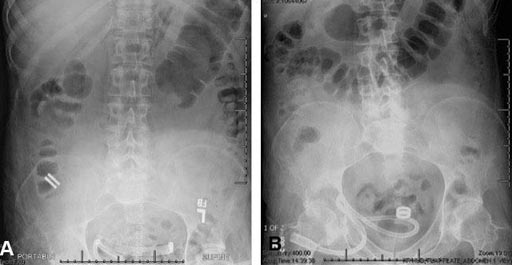Paired Magnets Create Bowel Anastomosis
By HospiMedica International staff writers
Posted on 06 Sep 2017
A new study describes how magnetic compression can be used to create an intestinal anastomosis without sutures or staples.Posted on 06 Sep 2017
Researchers at the University of California, San Francisco (UCSF; USA) conducted a first-in-human, prospective trial to evaluate the feasibility and safety of creating an intestinal anastomosis using the Magnamosis device, which includes a pair of self-centering magnetic Harrison rings (one convex and the other concave) in five adult patients requiring intestinal anastomosis to restore bowel continuity. One Harrison ring was placed in the lumen of each intestinal segment; the rings were then brought together and mated, and left to form a side-to-side, functional end-to-end anastomosis.

Image: Mated magnets soon after placement (A) and in the rectum one day before passage (B) (Photo courtesy of UCSF).
The researchers created the Magnamosis anastomosis in just 25-35 minutes. Device movement was monitored with serial x-rays until it passed in the stool, and patients were monitored for adverse effects with routine clinic appointments, as well as questionnaires. All five patients suffered no complications related to their anastomosis, including anastomotic leaks, bleeding, or stricture at median follow-up of 13 months, and all devices passed without obstruction or pain. The study was published on August 23, 2017, in Journal of the American College of Surgeons (JACS).
"The tissue between the magnets dies off, a hole forms from the necrotic tissue, and the surrounding area heals. Once the connection is fully formed, the magnets fall through the hole, pass into the bowel, and are excreted in the stool, leaving nothing behind,” said lead author Claire Graves, MD. “In animal studies, the Magnamosis device consistently created anastomoses that were comparable or better than hand-sewn or stapled alternatives.”
Intestinal resection and anastomosis is indicated for any bowel that is nonviable, neoplastic, perforated by a foreign body, intussuscepted, or has any other irreversible tissue damage. The two most commonly used anastomotic techniques are hand-sewn sutured anastomosis and stapled anastomosis. Successful intestinal anastomosis necessitates adequate exposure and access, gentle tissue handling, absence of tension and distal obstruction, hemodynamic stability with adequate tissue oxygenation, and meticulous surgical technique.
Related Links:
University of California, San Francisco














